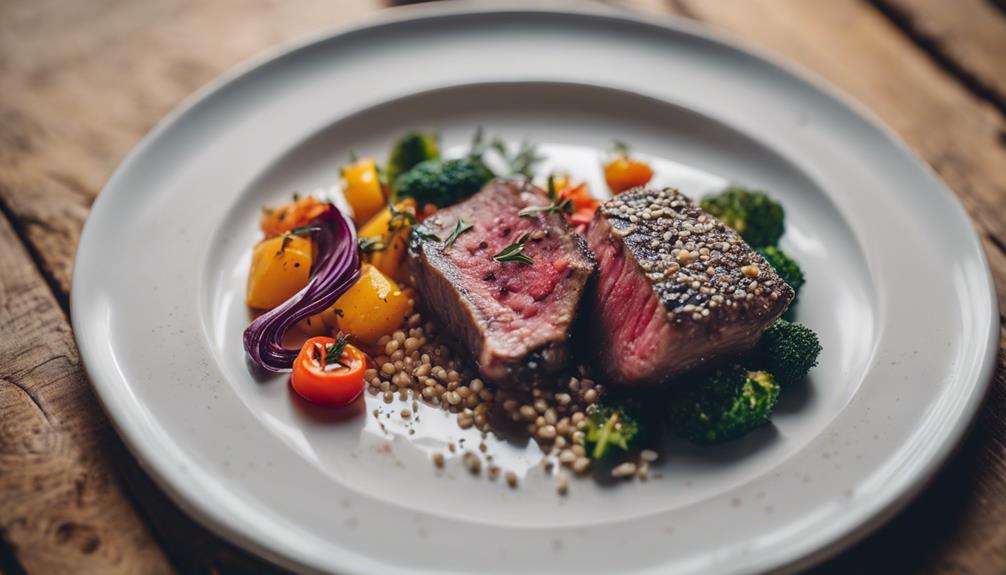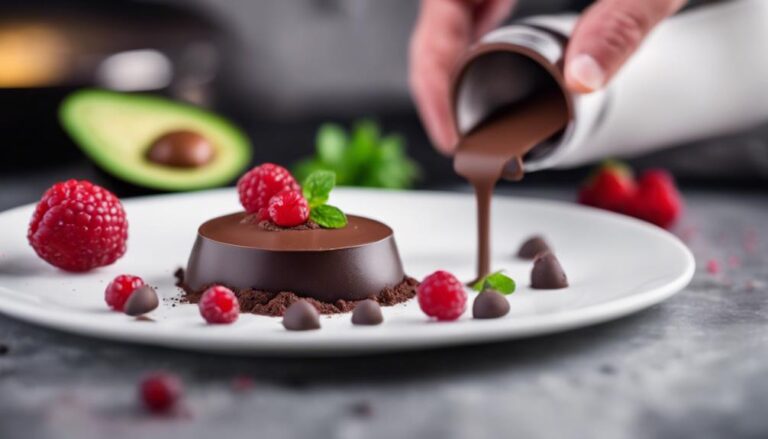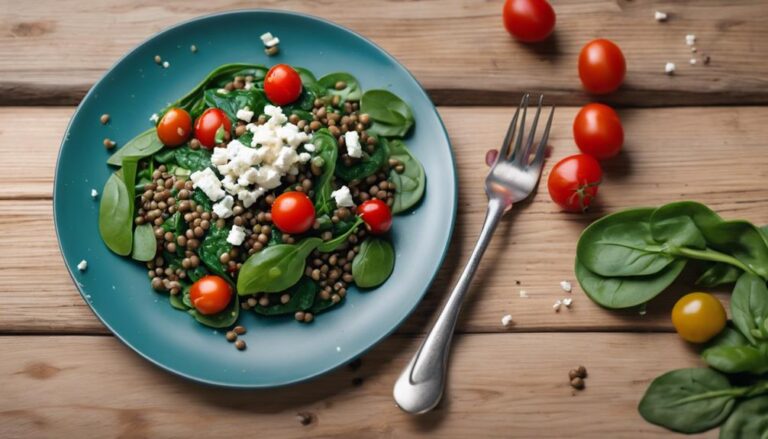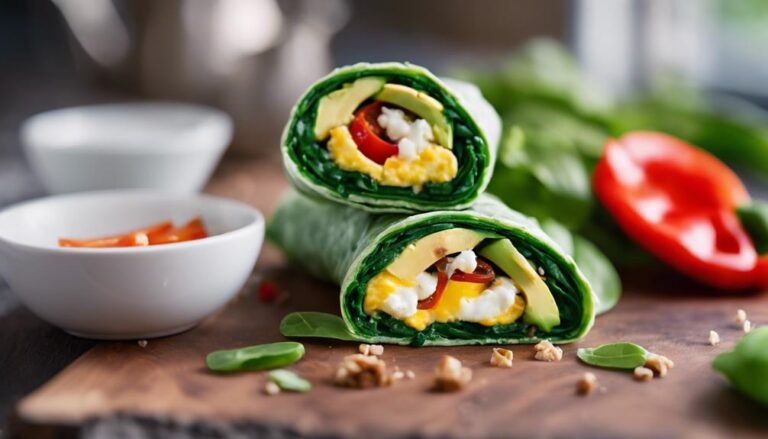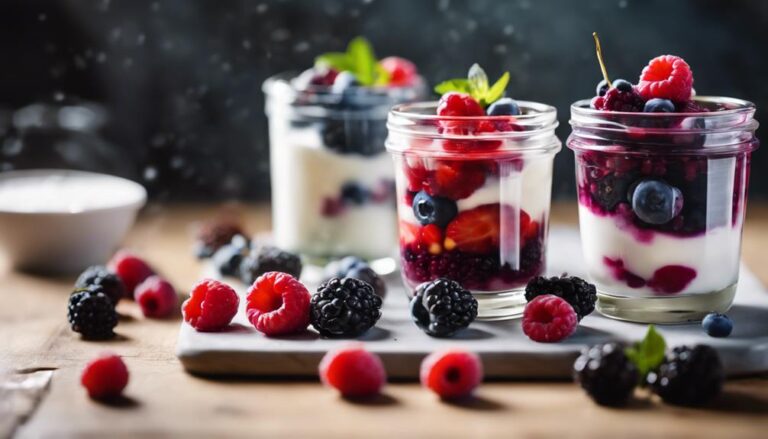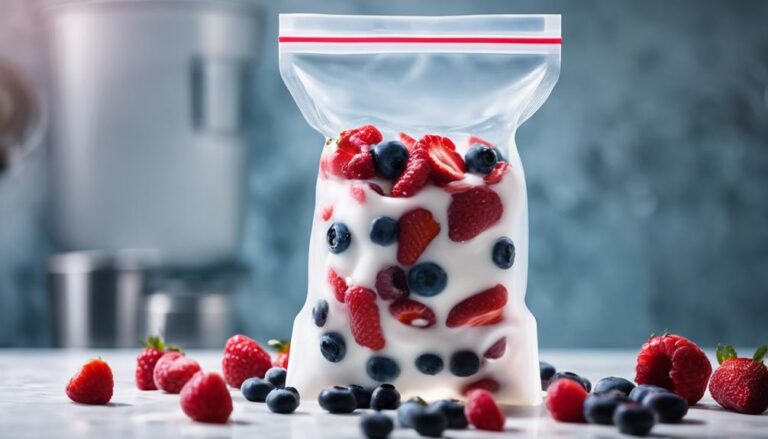Dive Into the Supercarb Diet With Sous Vide for Perfectly Balanced Meals
Immerse yourself in the Supercarb Diet by combining it with sous vide cooking for balanced, nutrient-dense meals. You’ll focus on high-quality carbs like quinoa and brown rice, paired with plant-based proteins and healthy fats.
Sous vide cooking guarantees even cooking, locking in flavors and nutrients, while saving time. This method makes portion control easy, supporting sustainable weight management. Include whole grains for fiber and sustained energy, and add colorful fruits and vegetables for essential vitamins.
The precise temperature control of sous vide perfectly complements the Supercarb Diet’s goal of creating nutritious, flavorful dishes. Discover how to master this blend for your meals.
What You Will Learn Here
- Sous vide cooking locks in nutrients and flavors, enhancing the Supercarb Diet’s high-quality, nutrient-dense meals.
- Batch cooking with sous vide ensures portion control and convenience for the Supercarb Diet.
- Sous vide maintains the texture and nutrient content of grains and vegetables crucial to the Supercarb Diet.
- Pair sous vide-cooked lean proteins with whole grains and plant-based proteins for balanced Supercarb meals.
- Sous vide promotes healthy cooking without excessive salts or fats, aligning with the Supercarb Diet’s principles.
Understanding the Supercarb Diet
The SuperCarb Diet is all about incorporating high-quality carbohydrates like quinoa and brown rice into your meals to guarantee balanced nutrition.
By focusing on these nutrient-dense carb sources, you’re setting a solid foundation for balanced meals that support your goals.
These carbs provide the necessary fuel for your body, helping to maintain steady energy levels throughout the day.
Understanding the right carb sources is important. Whole grains such as quinoa, brown rice, and oats are excellent choices.
They’re packed with fiber, vitamins, and minerals, which not only help you stay full longer but also support healthy digestion.
Including a variety of these carb sources in your diet ensures that your meals are both nutritious and satisfying.
Balanced meals are the cornerstone of the SuperCarb Diet. Pairing high-quality carbs with plant-based proteins and healthy fats ensures you’re getting a well-rounded mix of nutrients.
This balance is essential for maintaining steady energy levels, which is especially important if you’re dedicated to serving others and staying active.
Additionally, balanced meals can help regulate your blood sugar, preventing those dreaded energy crashes.
Achieving sustainable weight is another key benefit of the SuperCarb Diet. By focusing on whole, unprocessed foods and maintaining portion control, you can work towards your weight goals without feeling deprived.
Consistent energy levels and balanced blood sugar also play a role in making weight management more attainable.
Benefits of Sous Vide Cooking
Utilizing sous vide cooking can revolutionize your meal prep by guaranteeing juicier, more flavorful dishes every time.
This method uses precise temperature control to cook food evenly, resulting in perfectly balanced meals that are delicious and nutritious.
By vacuum-sealing your ingredients, you lock in all the natural juices and flavors, creating dishes with flavorful textures that are difficult to achieve with traditional cooking methods.
One of the standout benefits of sous vide cooking is its cooking precision. You can set the exact temperature you need, ensuring that your proteins are cooked to perfection without the risk of overcooking.
This leads to consistently tender and juicy results, making every meal a delight to serve and enjoy. Whether you’re cooking chicken, beef, or fish, the versatility of sous vide ensures that all proteins are cooked evenly, maintaining their best texture.
In addition to its precision, sous vide is a significant time-saving method. While the cooking process itself might take longer, the hands-on time is minimal. You can set your sous vide machine and walk away, giving you more time to focus on other meal prep tasks or attend to your guests.
This convenience is particularly beneficial when preparing multiple dishes or managing a busy kitchen.
Sous vide cooking isn’t just about convenience and precision; it also allows for versatile proteins and other ingredients.
From delicate fish fillets to hearty steaks, sous vide ensures each item is cooked to its highest possible state. By adopting this method, you’ll consistently achieve juicy results that will impress anyone you serve.
Key Components of a Supercarb Meal
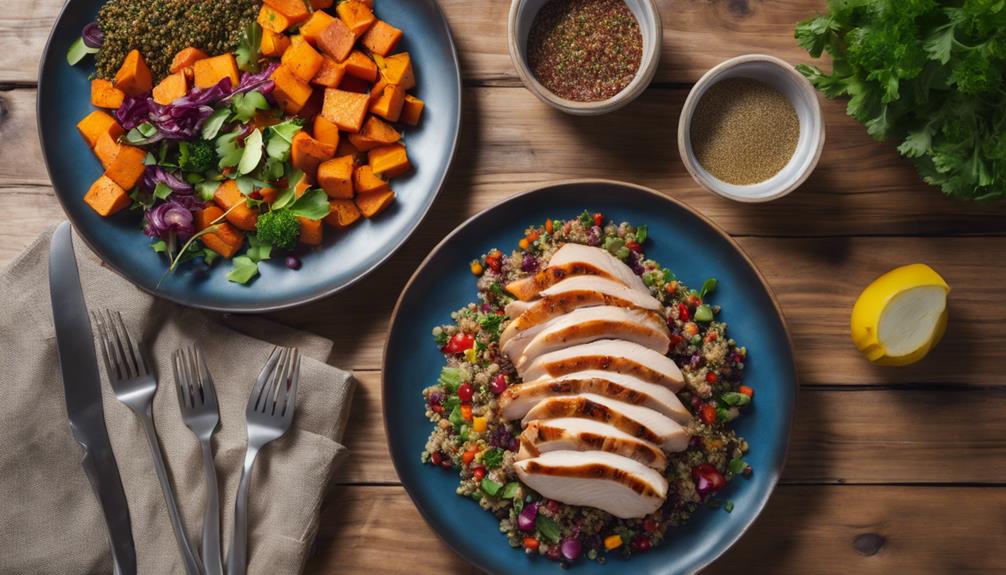
Incorporating high-quality carbohydrates, plant-based proteins, and healthy fats is vital for creating a balanced supercarb meal.
By focusing on these key components, you’ll guarantee that each meal provides the right nutrient balance to support your well-being and energy levels throughout the day.
High-quality carbohydrates, like quinoa, brown rice, and sweet potatoes, serve as the foundation of your supercarb meal.
These carbs are nutrient-dense, providing sustained energy and keeping you full longer.
Pair these with plant-based protein sources such as lentils, chickpeas, and black beans. These proteins not only support muscle repair and growth but also add essential fiber to your diet, aiding digestion and enhancing satiety.
Don’t forget the healthy fats! Incorporate ingredients like avocado, nuts, and seeds into your meals. They’re not only delicious but also essential for nutrient absorption and overall health.
Healthy fats help maintain cell structure and provide long-lasting energy, crucial for those who lead active lifestyles.
When planning your meal combinations, aim for a colorful plate filled with a variety of superfood options. Think about adding greens like spinach or kale, which are packed with vitamins and minerals.
This approach ensures that your meals aren’t only balanced but also visually appealing and satisfying.
High-Quality Carbohydrates to Include
You’ll find high-quality carbohydrates like quinoa, brown rice, and barley are essential for sustained energy and fiber on the SuperCarb Diet. These carb choices provide a steady release of energy, keeping you fueled throughout the day.
Quinoa, for instance, isn’t only a great source of carbohydrates but also offers a complete protein profile, making it a versatile addition to your meals.
Incorporating fiber sources such as legumes, lentils, and chickpeas can greatly benefit your digestive health.
These foods help maintain a healthy gut by promoting regular bowel movements and reducing cholesterol levels. Plus, the added fiber keeps you feeling full longer, which is key for portion control and preventing overeating.
Selecting carbohydrates with a low glycemic index is essential for managing blood sugar levels. Foods like sweet potatoes, berries, and whole wheat pasta release glucose slowly into your bloodstream, helping to avoid spikes and crashes in energy.
This steady energy supply is particularly important for those who aim to serve others effectively without the distraction of fluctuating blood sugar levels.
Don’t forget to include a colorful array of fruits and vegetables in your diet. Not only do they provide essential vitamins, minerals, and antioxidants, but they also add natural sweetness and variety to your meals.
When it comes to portion control, be mindful of how much you’re consuming to maintain balanced meals and avoid excessive calorie intake.
Plant-Based Proteins for Balance
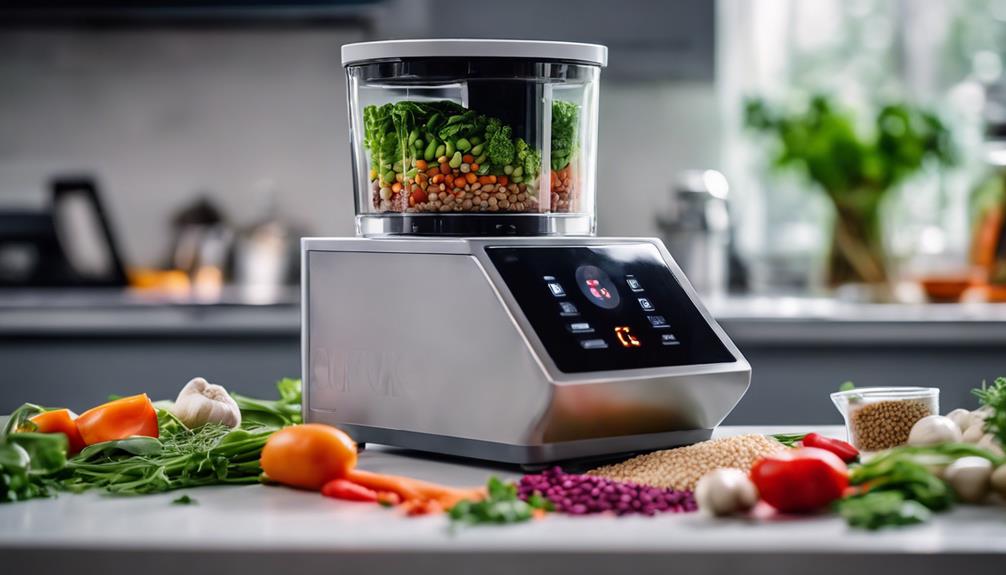
Plant-based proteins, such as quinoa, lentils, and chickpeas, are essential for achieving balanced nutrition in the SuperCarb Diet.
These protein sources aren’t only rich in essential amino acids but also packed with fiber and vitamins, making them a cornerstone of a nutritious diet.
By incorporating a variety of plant-based proteins into your meals, you’re guaranteeing a diverse nutrient intake that supports overall health and muscle growth.
Quinoa, for instance, is a complete protein, meaning it contains all nine essential amino acids your body needs.
Lentils and chickpeas are also excellent choices, providing substantial amounts of protein and fiber, which promote digestive health.
Including these foods in your diet can help you feel fuller for longer periods, enhancing meal satiety and reducing unnecessary snacking.
From a sustainability perspective, plant-based proteins are a fantastic option. They’re low in saturated fats, cholesterol-free, and have a smaller environmental footprint compared to animal-based proteins.
By choosing plant-based options, you’re not only taking care of your health but also contributing to sustainable eating practices.
When you incorporate a variety of these nutrient-rich plant-based proteins into your SuperCarb Diet, you’re setting yourself up for success.
The nutrient variety ensures that your body gets a wide range of vitamins and minerals, which is vital for maintaining energy levels and overall well-being.
Plus, the fiber content in these foods aids in digestive health, helping to keep your system running smoothly.
Incorporating Healthy Fats
Why are healthy fats essential for your diet on the SuperCarb plan? Healthy fats play a vital role in providing energy, supporting cell growth, and aiding in nutrient absorption.
By incorporating these fats into your SuperCarb diet, you can enhance your overall health and well-being.
First, consider the avocado benefits. Avocados are rich in monounsaturated fats, which can help reduce bad cholesterol levels and decrease your risk of heart disease.
They also provide a good source of fiber and essential vitamins, making them a versatile and nutritious addition to your meals.
Next, nutritional seeds like chia, flax, and hemp seeds are excellent polyunsaturated sources.
These seeds are packed with omega-3 fatty acids, which contribute to brain health and reduce inflammation. They can easily be added to smoothies, salads, or yogurt for an extra nutritional boost.
Finally, let’s not forget the olive oil advantages. Olive oil, particularly extra virgin, is another fantastic source of monounsaturated fats.
It’s known for its heart-healthy properties and contains antioxidants that can protect your cells from damage. Drizzle olive oil over your vegetables or use it as a base for salad dressings to enjoy its many benefits.
Here’s how you can incorporate healthy fats into your SuperCarb diet:
- Avocados: Add slices to your salads, and sandwiches, or blend into smoothies.
- Nutritional seeds: Sprinkle chia or flax seeds on top of your yogurt or oatmeal.
- Olive oil: Use as a dressing for salads or a cooking base for your sous vide dishes.
Balancing these healthy fats with quality carbohydrates and proteins will ensure a well-rounded and nutritious diet that supports your SuperCarb goals.
Whole Grains for Sustained Energy
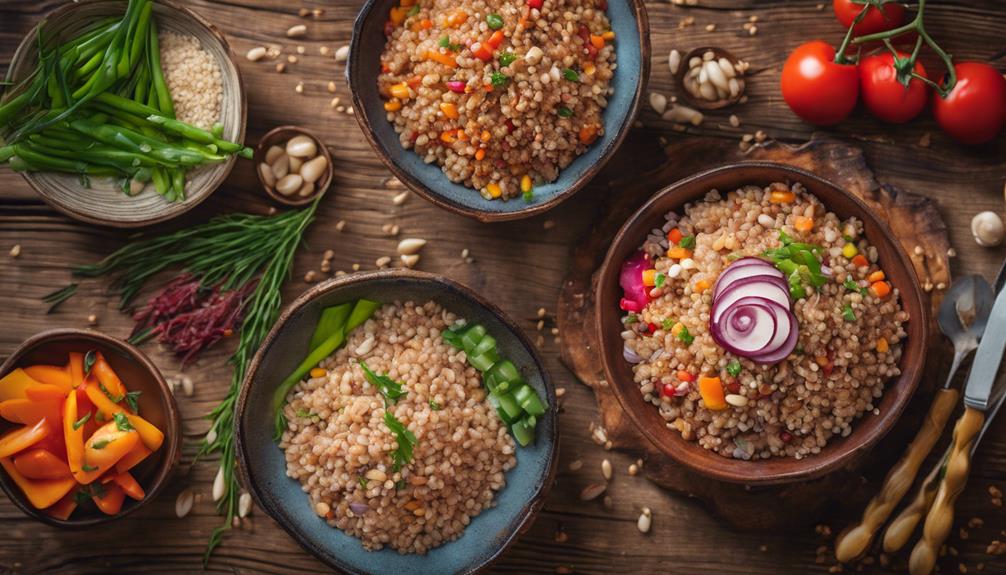
Incorporating whole grains like quinoa, brown rice, and barley into your SuperCarb diet guarantees you have sustained energy throughout the day.
These grains aren’t only important for energy sustainability but also fiber rich options that keep you feeling full and satisfied.
The slow digestion of these complex carbohydrates helps prevent spikes in blood sugar levels, ensuring balanced digestion and a steady release of energy.
By choosing nutrient packed grains, you’re not just feeding yourself; you’re fueling your ability to serve others.
Whole grains are loaded with essential vitamins and minerals that support overall well-being. For example, quinoa is a complete protein and contains all nine essential amino acids.
Brown rice is high in magnesium, which is important for muscle and nerve function. Barley is rich in selenium, which supports your immune system.
These grains collectively contribute to your body’s ability to perform at its best.
Energy sustainability is important for anyone dedicated to serving others, as it allows you to maintain high energy levels throughout the day. Including whole grains in your meals ensures you’ll experience sustained satiety, keeping you from reaching for unhealthy snacks that can derail your diet.
Their fiber content also aids in balanced digestion, promoting gut health and regularity.
Incorporating these fiber rich options into your sous vide meals is simple and effective. The sous vide method retains the nutrients and flavors of these grains, making them a delicious and nutritious component of your SuperCarb diet.
By prioritizing nutrient packed grains, you’re setting yourself up for success, both in your personal health and in your mission to serve others.
Supercarb-Friendly Fruits and Vegetables
When you’re following the SuperCarb Diet, selecting fruits like berries, apples, and citrus fruits along with vegetables such as leafy greens, bell peppers, and broccoli guarantees you receive a high-fiber and nutrient-packed meal.
These nutrient-rich picks not only support your overall health but also make sure you’re getting a balanced intake of essential vitamins, minerals, and antioxidants.
Incorporating supercarb-friendly fruits and vegetables into your meals helps stabilize blood sugar levels, promote satiety, and enhance digestive health.
To make the most of your diet, consider these superfood combinations and invigorating pairings:
- Leafy Greens and Citrus Fruits: Pair spinach or kale with oranges or grapefruits for an invigorating and nutrient-dense salad.
- Berries and Broccoli: Add a handful of blueberries or strawberries to a broccoli stir-fry for a burst of sweetness and antioxidants.
- Bell Peppers and Apples: Slice bell peppers and apples together for a crunchy, vitamin-packed snack.
Choosing colorful choices in your fruits and vegetables ensures a diverse nutrient intake. For example, the vibrant reds of strawberries and bell peppers are rich in antioxidants, while the greens of broccoli and spinach provide essential vitamins and minerals.
By focusing on seasonal selections, you can enjoy the freshest produce available, which often means better flavor and higher nutrient content.
Don’t forget to experiment with different superfood combinations to keep your meals exciting and varied.
Whether it’s a tangy citrus salad or a sweet berry stir-fry, these invigorating pairings can make your SuperCarb Diet both delicious and nutritious. Remember, the key to a successful diet is variety, so keep exploring new and colorful choices every season.
Sample Supercarb Diet Meal Plan

Crafting a sample Supercarb Diet meal plan helps guarantee you indulge in balanced, nutrient-rich meals every day.
Start your day with a breakfast bowl of quinoa, topped with fresh berries and a dollop of Greek yogurt.
It’s an excellent meal prep idea that maintains quality carbohydrates and protein, keeping you energized throughout the morning.
For lunch, try a mixed greens salad with chickpeas, avocado, and a light olive oil vinaigrette. This meal combines plant-based proteins and healthy fats for nutrient balance.
Remember to practice portion control to prevent overeating, even with healthy foods.
Your afternoon snack can be a handful of nuts and an apple. This combo provides a quick energy boost and essential nutrients without unnecessary calories. It’s also easy to carry, making it perfect for those busy days.
Dinner can be sous vide chicken breast paired with roasted sweet potatoes and steamed broccoli. This recipe idea ensures you get a wholesome mix of lean protein, quality carbs, and fiber-rich vegetables.
The sous vide method helps retain the chicken’s nutrients and flavor, making your meal both healthy and delicious.
If you’re dining out, don’t stress. Look for menu options that include whole grains, lean proteins, and plenty of vegetables.
You can always ask for modifications to suit your diet. For instance, request brown rice instead of white or double the veggies in your dish.
How to combine Sous Vide Cooking with the Supercarb Diet
Pairing sous vide cooking with the Supercarb Diet guarantees you get the most nutrient-dense and flavorful meals possible.
This powerful combination allows you to leverage sous vide techniques to enhance the benefits of the Supercarb Diet, making your meal preparation not only efficient but also exceptionally nutritious.
Sous vide cooking involves sealing food in airtight bags and cooking it in a water bath at precise temperatures. This method is perfect for the Supercarb Diet, which emphasizes nutrient retention and the consumption of high-quality carbohydrates.
With sous vide, you can make sure that your vegetables and grains retain their vitamins and minerals, providing maximum health benefits.
One of the standout features of sous vide is its ability to infuse flavors deeply into your ingredients.
For instance, you can infuse herbs and spices into sweet potatoes or quinoa, elevating their taste without the need for excessive salts or fats. This makes your supercarb meals more flavorful and satisfying.
Consider these meal prep strategies to combine sous vide cooking with your Supercarb Diet:
- Batch Cooking: Prepare large quantities of grains and vegetables in advance, using sous vide to maintain their texture and nutrient content.
- Flavor Pairings: Experiment with different herbs and spices to find combinations that enhance the natural flavors of your supercarb ingredients.
- Portion Control: Use sous vide to cook individual portions of meals, making it easier to manage your diet and avoid overeating.
Frequently Asked Questions
What Are the Disadvantages of Sous Vide Cooking?
Sous vide cooking has some disadvantages. The equipment cost can be high, requiring a sous vide machine and vacuum sealer.
Long cook times are common, which may not suit everyone’s schedule. Plastic waste from vacuum sealing can be concerning. Limited browning means you might miss out on crispy textures.
Additionally, the process uses significant water consumption, and some may find the setup and precise temperature control time-consuming.
Is Sous Vide Good for Meal Prep?
Yes, sous vide is great for meal prep due to its convenience and time efficiency. You’ll enjoy meal consistency, as the precise temperature control guarantees even cooking every time.
Nutrient retention is a big plus, as this method preserves more vitamins and minerals. Plus, flavor enhancement is a given since the food cooks in its juices.
It’s a straightforward way to serve others restaurant-quality meals at home.
Is Sous Vide the Healthiest?
Yes, sous vide is one of the healthiest cooking methods. It excels in nutrient retention and cooking precision, ensuring your food maintains its natural vitamins and minerals.
With sous vide, you can enjoy low-fat cooking since there’s minimal need for added oils. This method also enhances the flavor of your meals, making them both delicious and nutritious.
What Does Sous Vide Mean in French?
Sous vide means ‘under vacuum’ in French. This culinary technique involves vacuum sealing food in a bag and cooking it using a precise temperature-controlled water bath.
French chefs created this cooking method to maintain food quality and flavors. The precise temperature control guarantees consistent and tender results, making it a favorite among chefs for its ability to enhance flavors and retain moisture in dishes.
Conclusion
By embracing the SuperCarb Diet and sous vide cooking, you’ll enjoy balanced, nutritious meals that are both delicious and easy to prepare.
This innovative approach seamlessly combines high-quality carbs, plant-based proteins, and healthy fats, ensuring every dish supports your health and well-being.
With sous vide, you retain maximum nutrients and flavors, making your culinary journey both satisfying and guilt-free.
Start your SuperCarb Diet today, and watch your energy levels and culinary skills soar.
